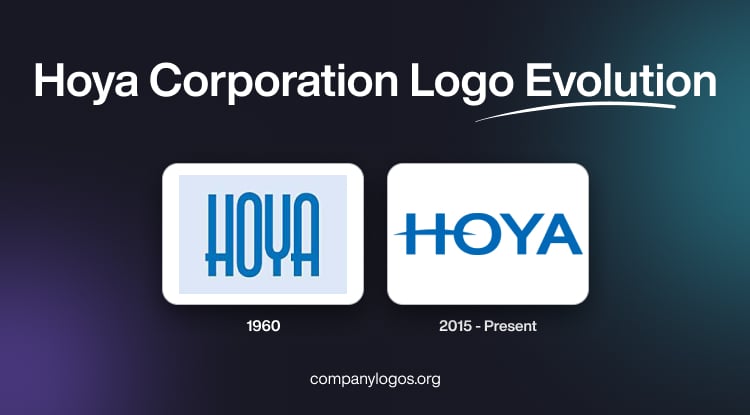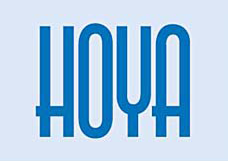
Hoya Corporation is a global medical technology company from Japan. It is renowned for delivering innovative high-tech and medical products across the healthcare and information technology sectors. It was established in 1941 as a manufacturer of optical glass and has since evolved into a leading supplier of eyeglass lenses, contact lenses, medical endoscopes, intraocular lenses, and diagnostic imaging systems. At the same time, it also provides advanced components for semiconductor devices, LCD panels, and hard disc drives.
The Hoya Corporation logo reflects the company’s roots in precision optics and its expansion into diversified technology. The logo showcases the transformation of Hoya Corporation from a local glassworks to a global technology leader. The article explores the logo evolution of the company, among other details.
The Genesis of the Hoya Corporation Logo (1941 – 1959) (Unavailable)
Although Hoya Corporation was established in 1941, there is no documented evidence of a formal modern logo in this period. It can be assumed that the logo during that period likely featured a simple logotype.
(1960)
A major milestone in Hoya’s brand history occurred in 1960, when several group companies were merged to form Hoya Crystal. This transition was accompanied by the introduction of a new corporate logo and was aligned with the company’s new slogan, “Exploring the functional possibilities of glass.” The logotype in blue featured the brand name “HOYA” in geometric uppercase with each letter stretched vertically. The letter “Y” looked more like a tuning fork, while the crossbars of the letters “H” and “A” appeared quite low. Furthermore, the letter “A” had a rounded top rather than a pointed one.

(1984 – 2015) (Unavailable)
In 1984, the company was officially renamed Hoya Corporation. However, there is no documented proof of the logo change that took place during the period. It can be assumed the logo is text-based, like its predecessor, but with better conveyed clarity and vision across industries.
(2015 – Present)
The current logo appeared circa 2015 and continues to this day. It features a modern “HOYA” wordmark in blue, which is written using a clear, modern, geometric sans-serif typeface. Interestingly, the crossbar in the letter “H” with pointed ends on either side spills into the letter “O”.

The Elements of the Hoya Corporation Logo
Font
The font is a custom, modern sans serif, conveying a sense of precision fitting for a company specialising in optics and technology.
Colour
The primary brand colour is a distinct blue, often associated with trust, vision, and transparency, and featured prominently in Hoya’s logo and corporate materials.
The History of Hoya Corporation
Hoya Corporation was founded on November 1, 1941, in Hoya, Tokyo, by brothers Shoichi and Shigeru Yamanaka. The company began as an optical glass production plant, and its entry into the market was driven by the postwar demand for high-quality optical glass in Japan.
In the 1940s and 1950s, Hoya quickly established a reputation as a supplier of optical glass and crystal products. It expanded its operations to meet the growing demand in Japan’s post-war recovering economy. The company was incorporated in 1944 and launched its well-known crystal products in 1945. By 1961, Hoya had achieved a major milestone by listing on the Tokyo Stock Exchange.
Hoya expanded into new optical fields by launching progressive multifocal lenses in 1967, and in 1972, it entered the soft contact lens market. The 1970s and 1980s also saw Hoya move into IC substrates and other advanced materials used in electronics.
In 1984, the company adopted the name Hoya Corporation to reflect its broader interests beyond optical glass. This period marked a renewed focus on research and development as it established a new R&D centre in the city of Akishima in 1986. Hoya launched intraocular lenses and aspherical moulded-glass lenses in 1987, which cemented its foothold in medical and life science technology.
Hoya established key subsidiaries across Europe, North America, and Asia and increased its international presence in the late 1980s and 1990s. The company became a global med-tech and high-tech supplier and had a business portfolio that spanned eyeglasses, medical endoscopes, intraocular lenses, and advanced components for semiconductors and data storage devices.
A decisive moment for the company came in 2007 when it acquired Pentax, a leader in medical endoscopes and imaging. This acquisition enhanced Hoya’s leadership in med-tech and broadened its product offering. Pentax’s integration gave Hoya critical expertise and IP in the field of flexible endoscopy and glass ceramics.
Hoya is recognised for innovation in information technology and healthcare solutions. It manufactures products for vision care, medical imaging, photonics, and electronics worldwide. The conglomerate has nearly 38,000 employees in about 30 countries and annual revenues exceeding ¥866 billion as of 2025.
Hoya has made significant investments in cutting-edge technologies, namely, photomasks, mask blanks for semiconductors, and high-index ophthalmic lenses. These ensure its enduring influence in global manufacturing, biotechnology, and med-tech. The company’s adaptability and commitment to quality remain central to its long-term success.
Interesting Facts About Hoya Corporation
- The company was founded on November 1, 1941 (then called Tokyo Optical Glass Manufacturing) by brothers Shoichi Yamanaka and Shigeru Yamanaka.
- The name “HOYA” originates from the city of Hoya (now part of Nishitōkyō) in Tokyo, where the original plant was located.
- HOYA began purely as a manufacturer of speciality optical glass, which was a highly advanced area at the time. Over the decades it expanded into many areas, such as eyeglass lenses, contact lenses, intraocular lenses, medical endoscopes, hard-disc glass substrates, photomasks for semiconductors, and other precision optics.
- As of their latest profile, HOYA has roughly 37,900 employees and operations in about 160 offices/subsidiaries globally.
- The revenues of Hoya Corporation are structured roughly into two main segments:
- 63.6% from Life Care (health/optics/medical).
- 35.9% from Information Technology (electronics/optical components).
- HOYA boasts a “recipe book” of over 50,000 ways to manufacture optical glass and produces more than 100 different varieties of optical glass tailored for diverse applications.
- According to investor-analysis write-ups, HOYA holds about 70% global market share in extreme ultraviolet (EUV) mask blanks and 100% in hard disc drive (HDD) glass substrates in certain segments.
- In 2007, HOYA made a friendly takeover of Pentax Corporation to bolster its medical optics business.
- It sold off the crystalware business (one of its earlier product lines) in 2009, which showed the shift away from decorative glass to high-tech & medical business.
- The company adopted global financial/operational reporting early. It voluntarily adopted IFRS for its FY ending March 31, 2011.
- Analysts have pointed out HOYA’s return on equity (ROE) has been high by Japanese standards (e.g., roughly in the ~17-20% range over various multi-year periods) and operating margins have been around ~30% in recent times.
- In March 2022, HOYA established an ESG Promotion Office and appointed a Chief Sustainability Officer. These initiatives are aimed at reviewing the business portfolio of the company to ensure long-term growth by both acquisitions and internal development.
- Apart from precision scientific/industrial glass, HOYA at one point produced crystal stemware and crystal chandeliers (in the mid-1940s).
- In the vision-care area, HOYA emphasises closing the “vision-care gap” in underserved communities. It leverages its global labs and networks to provide eye-health products and services.
Finally
The logo of Hoya Corporation has evolved from simple, functional signage to a modern, globally recognised wordmark. This evolution reflects changes in visual design as well as the company’s enduring commitment to clarity, technology, and innovative progress in optics.